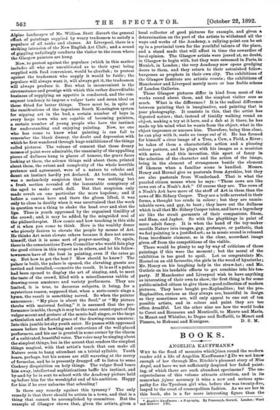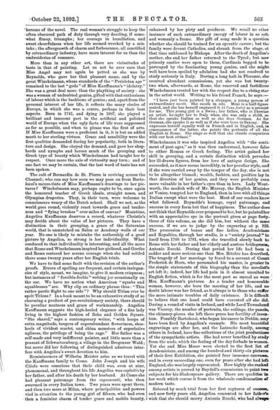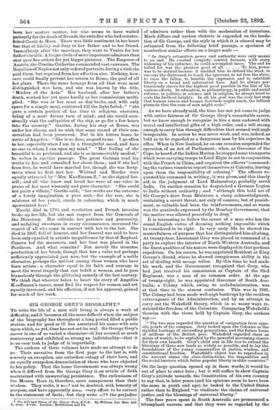BOOKS.
ANGELICA KAUFFMANN.* WHY to the flood of memoirs which:rises round the modern reader add a life of Angelica Kauffmann ?,/,' Do we not know enough of her through Mrs. Ritchie's pleasant story of Miss Angel, and have we not sufficiently despised her faded paint- ing, of which there are such abundant specimens ? The un- expectedness of this volume attracts attention, and in its somewhat jejune accuracy it wins a new and serious sym- pathy for the Tyrolean girl who, before she was twenty-five, leaped to the crest of cosmopolitan fashion. As we see her in this book, she is a far more interesting figure than the
• Angelico Kauffmann a B.ography. By Frances1A. Gerard. London; Ward and Downey 1392.
'heroine of the novel. The real woman's struggle to keep the often obscured path of duty through very dazzling, if some- -what flimsy, triumphs ; her courage in humiliation, and sweet cheerfulness when her life seemed wrecked by a mis- take; the aftergrowth of charm and forbearance, all sanctified by extraordinary industry, have more interest for us than the embroideries of romance.
More than in any other art, there are vicissitudes of taste in that of painting. Let us not be over sure that Miss Angel may not again be petted as she was by Reynolds, who gave her that pleasant name, and by the great Winckelmann, whose standards of the " Pericletan age" remained to the last " gods " of Miss Kanffmann's "idolatry." She was a great deal more than the plaything of society : she was a woman of undoubted genius, gifted with that enthusiasm - of labour which is the backbone of genius; and, apart from the • personal interest of her life, it reflects the many circles of Europe, in which she was a centre, perhaps in their best aspects. Born in 1741, and dying in 1807, she played a brilliant and innocent part in the artificial and polished world of Europe when the ugly facts of life were suppressed as far as possible, and when to please was the first of arts. If Miss Kauffmann were a proficient in it, it is but an added merit to her sterling virtues. Grace and sensibility were the first qualities demanded during her popularity, both in litera- ture and design. She obeyed the demand, and gave her shep- herds and nymphs and heroes much of the grouping and Greek type of beauty which Winckelmann had taught her to respect. Once more the axis of virtuosity may turn ; and of • one fact we may be certain, that the last word of taste has not been spoken.
The cult of Bernardin de St. Pierre is reviving across the Channel ; who can say how soon we may pass on from Barto- lozzi's mezzo-tints of Miss Kauffmann's drawings to her pic- tures P Winckelmann may, perhaps ought to be, once again the honoured teacher of Greek ideals, straight noses, and Olympian draperies. They, in their turn, were welcome to - connoisseurs weary of the Dutch school. Shall we not, as the world goes round, violently react towards grace and tender- ness and "flying brushes" over miles of canvas? Meantime, Angelica Kauffmann deserves a record, whatever Christie's may decide about the value of her pictures. They have a - distinction in their grouping, a grace of the Saturnian world, that is unmatched on Salon or Academy walls of our year. No one is likely to mistake the authorship of a good picture by Angelica, so strong is her individuality. What • conduced to that individuality is interesting, and all the more that Rome and Winckelmann inspired her girlhood, and Goethe and Rome restored her serene courage when she had settled there some twenty years after her English trials.
We have to find some fault with the revision of the author's proofs. Errors of spelling are frequent, and certain inelegan- cies of style, meant, we imagine, to give it modern crispness ; but instances of "forcible-feeble" writing jar occasionally on the ear. We have no notion what American "squabs and • squabbesses " are. Why clip an ordinary phrase thus : "This rather poetic flight to one side " ? Why should Titian ever be spelt Titiens ? In a book meant to be an exhaustive study of so charming a product of pre-revolutionary society, there should be peculiar neatness and grace of workmanship. Angelica Kauffmann suggests the high-heeled elegance of a fine lady living in the highest fashion of Soho and Golden Square. "She shared," says a contemporary writer, "with hoops of extra magnitude, toupees of superabundant floweriness, shoe- heels of vividest scarlet, and china monsters of superlative ugliness, the privilege of being the rage." Her father was a self-made and very indifferent painter, and little more than a peasant of Schwartzenburg, a village in the Bregenzer Wald ; but never did her following of distinguished admirers inter- fere with Angelica's sweet devotion to him.
Reminiscences of Wilhelm Meister arise as we travel with the Kauffmann family to Como. John Joseph and his wife
• Cleofe were conscious that their child was, even at nine, phenomenal, and throughout his life Angelica was exploit& by her father, and after his death by her husband. At Como she had pleasant patronage from the cognoscenti, who then swarmed in every Italian town. Two years were spent there, and then two more at Milan, where principalities and powers vied in attention to the young girl of fifteen, who had even then a feminine charm of tender grace and mobile beauty,
enhanced by her piety and goodness. We recall no other instance of such extraordinary energy of labour in so soft, and womanly a frame. Her gift of song made it a question whether she should be trained for an operatic career; but the family were devout Catholics, and shrank from the stage, at that time unblessed by Bishops. After the death of Angelica's mother, she and her father returned to the Tyrol ; but now princely castles were open to them, Cardinals begged to be portrayed by the fascinating young genius, and she might well have been spoiled by adulation had she not resolved to study seriously in Italy. During a long halt in Florence, she received abundant commissions, yet she was but twenty- two when, afterwards, at Rome, the reserved and fastidious Winckelmann treated her with the respect due to a rising star in the artist world. Writing to his friend Franck, he says :—
" I have just been painted by a stranger, a young person of extraordinary merit. She excels in oils. Mine is a half-figure seated, and she has herself engraved it (d, l'eau forte) as a present for me. This young girl is a Swiss; her father, who is likewise an artist, brought her to Italy when she was only a child, so that she speaks Italian as well as she does German. As for German, she speaks it as well as if she were born in Saxony. he expresses herself equally well in French and in English, and, in - consequence of the latter, she paints the portraits of all the English in Rome. She sings so well that she stands comparison with our best virtuosi."
Winckelmann it was who inspired Angelica with "the senti- ment of past ages," as it was then understood, however false to either Roman or Greek feeling. The artist gained her skill in grouping, and a certain distinction which pervades ' her ill-drawn figures, from her love of antique design. She succeeded, as it now seems incredibly, in her peculiar style, and • if she were carried away by the temper of the day, she is not ' to be altogether blamed ; wealth, fashion, and position lapin that direction of her genius, and they were probably even more valuable in her father's eyes than in hers. Lady Went- worth, the modish wife of Mr. Murray, the English Minister at Venice, tempted her to England, then in love with all things Italian except what were the best. Most of our readers know what followed. Reynolds's homage, royal patronage, and success in every form but that of happiness. The author does not think that Reynolds ever proposed to her, but he paintedher with an appreciative eye in the portrait given at page forty-
three of this volume, as she did him, but without the saute success, if we are to judge by the engraving at p.
The procession of beaux and fine ladies, Academicians and Royalties, through her studio, is a "society journal" in itself from 1766 to 1781, when she travelled slowly back to
Rome with her father and her elderly and austere bridegroom, Antonio Zucchi. During that period her life had been a sadder and more serious one than Mrs. Ritchie has described. The tragedy of her marriage by fraud to a servant of Count • Frederick de Horn, who personated his master, is greater in
the simple statements of this biography than the novelises art left it; indeed, her life had pain in it almost unsuited to
English fiction, which is for the most part as unreal as were Mrs. Kauffmann's pictures. As a tender and honourable r
woman, however, she bore the marring of her life, and no doubt labour was her friend, as it always is to those who suffer the more intimate troubles of daily existence. It is difficult to believe that one hand could have executed all she did.
During a round of visits in Ireland, and while Lord Townshend was Viceroy, the number of portraits, the ceilings, the panels, the chimney-pieces she left there prove her fertility of invest- , tion. Possibly Bartolozzi, who began hiicareer in Dublin, may. have been fired by Angelica's example. His most beautiful engravings are after her, and the Latouche family, amcnyr others in Ireland, have fine collections of the joint productions , of the sympathetic artists. She had never benefited by study from the nude, which the feeling of the day forbade to women. • Yet she and Miss Moser were elected to the first list of Academicians, and among the hundred and thirty-six pictures
of their first Exhibition, she painted four immense canTaese, and in every succeeding one, even for years after she had left England, she was largely represented. How highly she ranked among artists is proved by Boyden's commission to paint two subjects for his Shakespeare gallery. There are qualifies% her work which rescue it from the wholesale condemnatian if modern taste.
Sobered by much trial from her first raptures of success, and now forty years old, Angelica consented to her father's wish that she should marry Antonio Zucehi, who had always been her austere mentor, but who seems to have waited patiently for the death of Brandt, the swindler who had counter- feited Count de Horn. There was little sentiment in her heart but that of fidelity and duty to her father and to her friend. Immediately after the marriage, they went to Venice for her father's health. A larger circle of more important admirers than ever gave her orders for yet bigger pictures. The Emperor of Austria, the Czarina Catherine commanded vast canvases. The Royalties of Naples not only ordered portraits during a visit she paid them, but required from her affection also. Nothing, how- ever, could finnlly prevent her return to Rome, the goal of all her plans. There the same homage from all that were most distinguished was hers, and she was known by the title, "Mother of the Arts." Her husband, after her father's death, worked her yet more hardly as her commissions multi- plied. "She was at her easel as day broke, and, with only space for a simple meal, continued till the light failed;" "she gave a certain portion of her time to religions exercises, being of a most devout turn of mind ; and she would occa- siona,lly visit the antiquities of the city, or go for a few hours into the country." Groethe, during his stay at Rome, was under her charm, and we wish that some record of their con- versation had been preserved. But in his letters home he -wrote of Angelica : "She is so dear, so good to me. I go often to her, especially when I am in a thoughtful mood, and have no one to whom I can open my mind." "Her feeling of the beautiful is so profound, and she is so inconceivably modest," he writes in another passage. The great German read his works to her, and consulted her about them ; and if she had been free, he would have married her, though she was forty- seven when he first met her. Wieland and Herder were equally attracted by "Mrs. Kauffmann Z.," as she signed her- self ; and all who knew and loved her were of one voice in praise of her most womanly and pare character. "She could not paint a villain," Goethe said; "her works are the outcome of a lovely imagination, a pure soul,—for the rest, she is mistress of her pencil, excels in colouring, which is much appreciated here."
Zucchi died in 179G, and revolution and French invasion broke up her life, but she met respect from the Generals of the Directory. Her solitude, her patience and generosity, - and unfailing sweetness in every circumstance, increased the regard of all who came in contact with her to the last. She died in 1807, full of honour, and her funeral was said to have been only equalled in artistic magnificence by that of Raphael. Canova led the mourners, and her bust was placed in the Pantheon. And what remains? Not merely the immense production of her brush, though that has a value not perhaps sufficiently appreciated just now, but the example of a noble character, perhaps the noblest among those women who have been artists : a character equal in its faith and courage to meet the worst tragedy that can befall a woman, and to pass blamelessly through the glittering comedy of the last century. We think that whoever takes to heart the story of Angelica ICauffmann's career, must find his respect for women and art equally increased, and his affection, if not his approval, gained for much of her work.








































 Previous page
Previous page